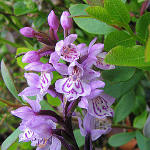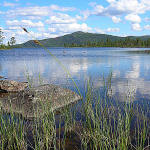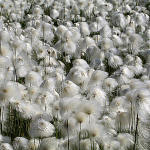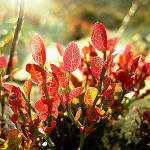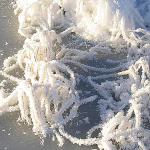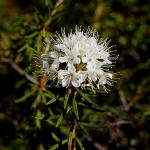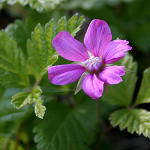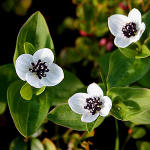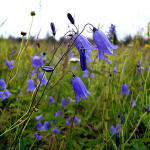

Home
Area
Vätsäri
Övre Pasvik
Pasvik Zapovednik
Nature
Geology
Climate
Water system
Flora
Fauna
Culture
Population
Religion
Sources of livelihood
Old ways of life
Time of industrialism
History
Stone Age
Early Metal Age
Late Metal Age
Middle Ages
Towards modern times
Timeline
Cooperation
Nature monitoring
Nature tourism
Publications
Contacts
Visit Pasvik-Inari
Guidelines
Regulations
News
Links
Flora
Forest of few species
In the vast pine forests surrounding the Pasvik River, Scots pine (Pinus sylvestris) dominates. Birch (Betula pubescens) is the most common deciduous tree, but in addition goat willow (Salix caprea), aspen (Populus tremula) and rowan (Sorbus aucuparia) grow in the forest. Bird cherry (Prunus padus) is found at lush river shores. The typical ground vegetation of the pine forest consists of coarse brushes. Species richness is modest in the north where the soil is barren. Some interesting species, however, are found such as green spleenwort (Asplenium viride), which grows on the areas of limestone rock. These habitats are rare, and in Vätsäri only one has been found.
The closeness of sea affects the flora especially in the northeast part of the area where the snow cover is thin and the temperatures are lower during the winter. Dwarf cornel (Cornus suecica), oak fern (Gymnocarpium dryopteris) and mosses are common.
Species typical of alpine heath are few. On the highlands of Vätsäri, however, alpine azalea (Loiseleuria procumbens), alpine club moss (Diphasiastrum alpinum) and blue mountainheath (Phyllodoce caerulea) are common.
Species from east and west
Pasvik-Inari area lay between vegetation zones where both eastern and southern influences affect the vegetation. Some species common in other parts of Finland and Russia, as the silver birch (Betula pendula) and arctic raspberry (Rubus arcticus) are less abundant in Pasvik. Examples of the eastern influences are Siberian spruce (Picea abies spp. obovata) and red cottongrass (Eriophorum russeolum), which are less common elsewhere in Norway.
Wetland specialities
On the wetlands in Pasvik River surroundings, you may find interesting sedge species like Lapland sedge (Carex lapponica) and weak sedge (Carex laxa). Orchids are typical wetland species. The most typical orchids on bogs are springs early purple orchid (Dactylorhiza maculata) and the southern creeping lady's tresses (Goodyera repens). On the river banks also tormentil (Potentilla erecta), outstanding purple moorgrass (Molinia caerulea) and several sedges (Carex sp.) grow. Great tussocks of smooth black sedge (Carex nigra var. juncea) are common also on the regulated shores of Lake Inari.
Modest flora of the meadows
The human impact has not been great in the wilderness. However, habitats created by people exist. On the field meadows of the old huts the vegetation is very different from the surrounding forest. Red fescue (Festuca rubra) and tufted hair grass (Deschampsia cespitosa) are common grasses in the meadows. Common yarrow (Achillea millefolium), and goldrute (Solidago virgaurea) are abundant. In other part of Lapland the globeflower (Trollius europaeus) is more common than in Pasvik. The reason for this is thought to be the short distribution time after the glacial period.
